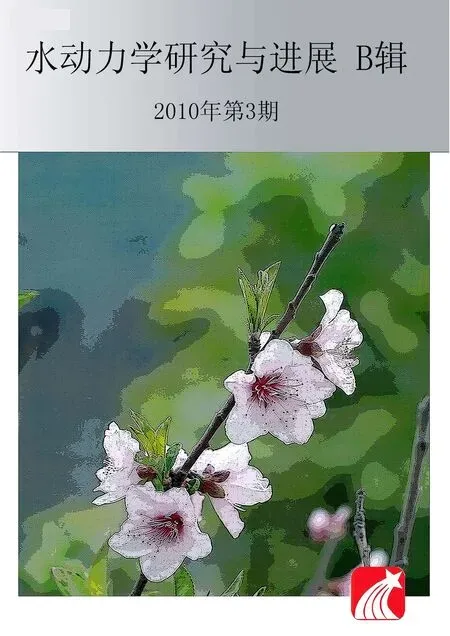SALT-FINGERING OF POLLUTANT VERTICAL MIXING IN STATIC THERMAL-STRATIFIED WATER*
CHEN Bo, LUO Lin, LI Jia
State Key Laboratory of Hydraulics and Mountain River Engineering, Sichuan University, Chengdu 610065, China, E-mail: kobeblnt@yahoo.com.cn
BAI Xue, LI Shao-bo
College of Architecture and Environment, Sichuan University, Chengdu 610065, China
SALT-FINGERING OF POLLUTANT VERTICAL MIXING IN STATIC THERMAL-STRATIFIED WATER*
CHEN Bo, LUO Lin, LI Jia
State Key Laboratory of Hydraulics and Mountain River Engineering, Sichuan University, Chengdu 610065, China, E-mail: kobeblnt@yahoo.com.cn
BAI Xue, LI Shao-bo
College of Architecture and Environment, Sichuan University, Chengdu 610065, China
Pollutant vertical mixing in stratified waters is a key factor that affects the vertical pollutant distribution in deep thermal-stratified reservoirs. This article presents an experimental study of the vertical mixing in thermal-stratified waters and an analysis of the retarded tracer jet diffusion in the thermocline layer. In the experiment, Reynolds number rapidly decreases from 104to 101. The stronger the stratification, the more seriously retarded the mixing will be. Some small tracer blobs may penetrate the thermocline layer into the hypolimnion layer even the main tracer cloud is retarded. According to its appearance, it can remain with salt-fingering, where the blobs are isolated away from the main cloud and mixed with the surround cold water in the hypolimnion layer. Therefore, the vertical distribution of the tracer under the thermocline layer would take larger values than expected. According to measurements, the isolated blob contents are accounted for about 5%-20% of the main tracer cloud, and are decreased with the increase of the stratification intensity. Results also show that the stronger the stratification, the smaller finger width would be. The averaged width of the incipient fingers is proportional to –0.3272 power of the temperature gradient, ΔT/Δz , or −0.2823 power of the thermal Rayleigh number,RaT, in the turbulent jet fluid.
thermal-stratified water, vertical mixing, retard, double diffusion, salt-finger
1. Introduction
A number of huge and deep reservoirs were built and are being built in the southwest of China. Thermal-stratification was usually observed in these reservoirs[1]. To deal with pollutant diffusion, or unexpected pollution incidents in these reservoirs and to provide support for decision-making, one should have a good understanding of the vertical mixing mechanism in stratified reservoirs.
In the stratified geophysical systems (lakes, fjords and oceans) and the interior of a stratified ocean, the diapycnal mixing was often considered[2]. Twoand three-dimensional numerical simulations of mixing in a stably stratified shear layer also revealed diapycnal mixing[3]. Fan et al.[4]investigated the vortex formation for a round transverse jet in shallow water. Qiu[5]found that the vertical turbulent intensity is affected by stratification, and vertical fluctuations decay more rapidly with the presence of stratification.
Double-diffusive fingering convection is important in many engineering applications and natural processes. Fingering instability occurs in a double-diffusive fluid layer in which the faster-diffusing component (heat) is stabilizing andthe slower-diffusing component (solute) is destabilizing[6]. In a heat-salt double diffusion, the potential energy locked in the unstable component is released through the more rapid molecular diffusion of heat than salt[7]. The strong layering in the ocean was observed near fronts, where large horizontal gradients of temperature and salinity were present. Turner measured the vertical fluxes of heat and salt across an interface containing fingerings[8]. He related the magnitudes of the fluxes of heat and salt to the temperature and salinity of the layers on either side of the interface, and demonstrated that the vertical transport of salt was considerably increased by the presence of the fingering. Green and Diez found that fingering convection increased the transport of plankton[9]. The finger structure was also observed in the sediment movement by Chen[10], when the finger was in the formation stage, vortex rings were seen forming at the tip of individual fingers, as observed by Green[11].
Turner proposed the density stability ratio,[6]Rρ=αΔT/βΔS, to indicate the relative strength of double diffusion, whereα=−ρ−1∂ρ/∂Tis the thermal expansion coefficient of the order of 10-5,β=ρ−1∂ρ/∂Sis the haline contraction coefficient of the order of 10-4,ρis the density, and ΔT, ΔSare the vertical temperature and salinity gradients, respectively[12]. The rates of transport of salt and heat depend on the characteristics of the convection cell, such as the fluid velocity and the width of the fingers, and the intensity of turbulence in the mixed layers across the fingering region[13]. Sreenivas et al.[14]studied double-diffusive fingering convection with two-dimensional numerical simulations, results of these simulations indicated that finger width was inversely proportional to the thermal Rayleigh number,Ra=gαΔTd3/νk, wheregis the gravity
TTacceleration,νis the kinematic viscosity of the fluid,kTis the thermal diffusivity, anddis the vertical characteristic length, ΔTis the temperature difference across the vertical characteristic length. The interaction between salt fingers and turbulence was well reviewed by Taylor[15]. He found that the fingers tend to be disrupted by the turbulent motions, and that fingers reform quickly after turbulent disruption.
Studies of vertical mixing in stratification water are usually focused on diapycnal mixing, while studies of double diffusion emphasize the diffusion of two components of different molecules, which was rarely considered in jet diffusion in stratification waters, and was generally investigated in a static system. The turbulence kinetic energy of a huge and deep reservoir is very low, its vertical mixing is mainly affected by the vertical temperature gradient structure. In this article, in order to understand the pollutant diffusion mechanism, the tracer diffusion in static state thermal-stratified waters was investigated in the laboratory, measurements of the detailed structure of laboratory heat-solute fingers were made, and the impact of turbulence on the double-diffusion was closely observed.
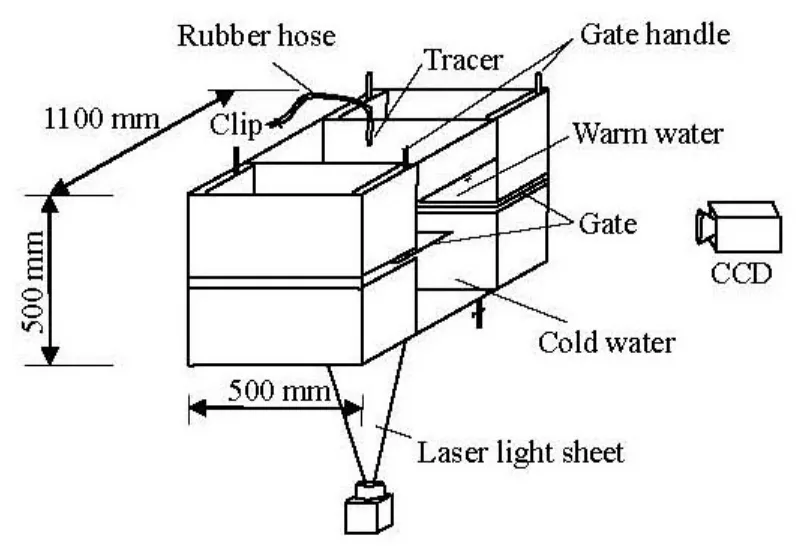
Fig.1 A diagram of the apparatus
2. Experimental setup
A two-layer thermal-stratification environment is created in a rectangular tank (Fig.1), in which a gate is placed in the middle to separate the initial layers. The experiments were carried out in a Perspex tank of 500 mm×500 mm in cross-section and 500 mm deep. In the tank, the cold water was deposited in the lower part, and then the warm water was introduced into the upper part. When the gate was removed slowly, a stratified water body was obtained. The different water temperatures of the layers lead to different stratification intensities. A rubber hose was used to release the tracer (Fig.1). The tracer was stored in one end and held by clipping the other end of the hose before the experimental run, and then it was released right at the center near the water surface by opening the clip. According to the measurements, the water body thermal-stratification structures were almost in a steady state during the experimental runs. Figure 2 shows the selected stratification curves at different time, whereZis the depth.
5 different densities of tracers were investigated in the experiments, including aqueous solutions of NaCl with Rhodamine B or Sodium Fluorescein (Table 1). The density of the tracer was measured by Anton Paar Density Meter DMA 35n. Figure 3 summarizes the tracers’ temperature-density profiles.gradient (ΔT/Δz) is the average change rate of the monitored vertical temperatures (with temperature probes being arranged horizontally and the averaged value of probes being taken at the same level probe), ΔTis the difference in temperature of adjacent levels,

Fig.2 Temperature profile variation at different elapsed time

Table 1 Details of tracer ingredient
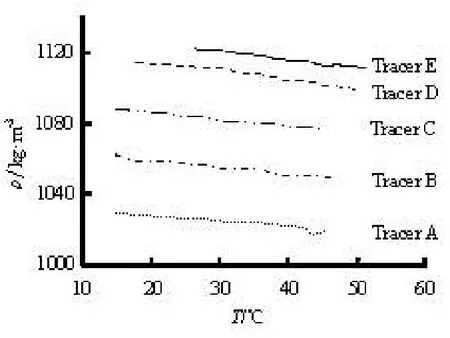
Fig.3 Tracer temperature-density profiles
The vertical mixing behaviors of tracers A, B, C and D were recorded by a video camera. Then Planar Laser Induced Fluorescence (PLIF) technique was used. As Rhodamine B excitation fluorescence is affected by temperature, Sodium Fluorescein was chosen as the tracer in this case[16]. The plane of the laser sheet, beamed from the tank bottom, is perpendicular to the water surface, and passes the center of the release hose (Fig.1).
88 experimental runs were performed including different combinations of tracers and stratification intensities, where isotherms of temperature field were almost horizontally distributed. The temperature and Δzis the difference of adjacent levels in height (10 mm in our measurements). The release amount of tracers A, B, C and D is 5 ml each. In PLIF experiments, the release amount of tracer E is 0.4 ml. High speed camera was used to monitor and measure the release velocity, and the velocity of water-entry was 250 mm/s - 300 mm/s. When the tracer was released at the water surface, the release velocity was considered as zero. Each experimental run took 1 min - 5 min starting from the tracer releasing to reaching its stable state. After the video was recorded for each run, the electronic thermometers were used to measure the water body temperature field. It was found that the temperature field structure of the water body was very little disturbed by the tracer release.
3. Experimental results and discussions

Fig.4 Typical examples of vertical mixing observed (in video camera recording)
It is found in all cases that the tracer vertical mixing was retarded at the thermocline layer due to the density gradient of the water body, where Reynolds numberRe=uL/ν(uis the forward speed of tracer cloud,Lis the width of cloud) was rapidly decreased form 104to 101. The stronger the stratification, the more seriously retarded the mixing will be, as illustrated in Figs.4 and 5. In a weak stratification, the tracer cloud settles slower than in the condition without stratification with the coniform movement the same as in the experiment of Ma and Li[17]. When the cloud went through the thermocline layer, its short stay at the layer made it more concentrated in the layer quite different from a coniform. When the stratification intensity increases, the whole cloud would stay in the thermocline layer. In a strong stratification, the buoyancy behind the thermocline layer, acting like a flexible film, pushes back the rapidly sinking density tracer cloud, and restores it to a plane in the thermocline layer. But the cloud in the thermocline layer did not mix just as in the Fickian’s diffusion, with the vertical diffusion coefficientKzmuch larger than the molecular diffusivity of salt, asKsalt/Kz~10-3-10-5, which agrees with Linden’s result[18], 10-4, and some small tracer blobs may penetrate the thermocline layer into the hypolimnion layer (Fig. 4 Moderate stratification).
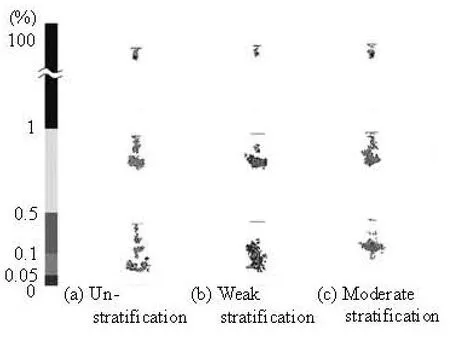
Fig.5 Typical examples of tracer concentration field (PLIF experiment) (The right side and the lower side of each picture are the vertical and the horizontal integral concentration distributions, the dark line of the vertical integral concentration distribution is the location of cloud barycenter)
According to its appearance (Fig.6), this type of phenomenon was considered as the salt-fingering. The structure of a single finger is illustrated in Fig.6. The finger width is defined as the widest size of the root of a single finger. The finger’s main body is a vortex ring, with a tracer trail along its trajectory. When the salt-fingering occurs, the blobs are broken away fromthe main tracer cloud and mixed with the cold water in the hypolimnion layer, so the vertical distribution of a tracer would take higher value than what expected.
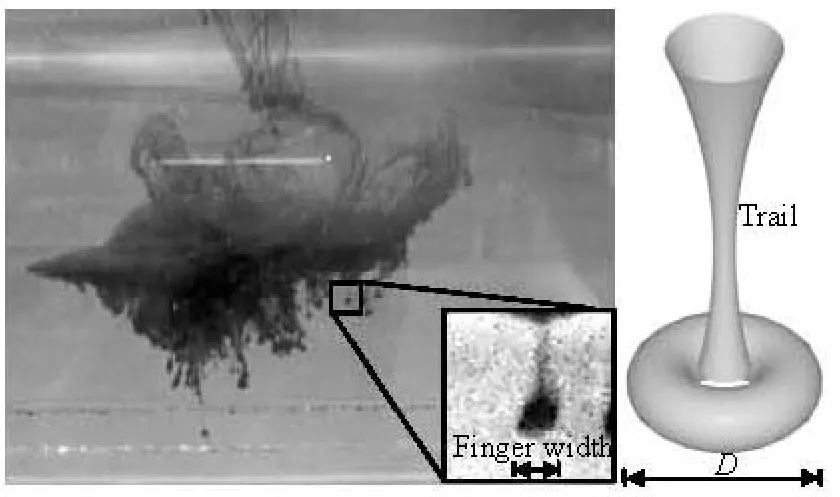
Fig.6 The salt-fingering and the illustration of a finger structure
According to the observation, there are two ways to form a salt-finger:
(1) When the tracer cloud sinks, the thermocline layer would try to hold up the whole cloud. But under specific conditions, some tracer blobs pass through the thermocline layer, just like through a filter. It would likely happen because of the tracer vortex and the density difference, with higher concentration and kinetic energy in the core of the vortex, some part of it may become heavy enough and with sufficient energy to sink deep to penetrate through the thermocline layer to become the blobs (finger), with a pattern very similar to Li’s observation[19](see Fig.2 of this article). As the stratification intensity increases, the buoyancy becomes stronger, only the heavier vortexes with higher kinetic energy could pass through the “filter.” In this forming condition, the finger is much bigger than what would occur in the next condition.
(2) In a strong stratification, the tracer cloud is held up and crushed at the thermocline layer, with high potential energy and in vertical vibration in the thermocline layer. A strong double-diffusive convection occurs in the thermocline layer because of density variation and tracer concentration difference. Salt-fingers appear, which would penetrate the thermocline layer and sink rapidly into the hypolimnion layer. The cloud, crushed at the thermocline layer, with high turbulent energy and many small eddies, would help to form the convective cells. The stronger the stratification, the more seriously retarded the mixing would be, which means that the cloud has higher potential energy, and smaller fingers would appear to dissipate the energy[14]. In this condition, the fingers are relatively smaller and with higher velocity than the main cloud movement.
In the first situation, the velocity of each finger is close to that of the cloud without stratification, so the movement of fingers can be considered as an extended movement of the tracer cloud. In the second situation, the velocities of the salt-fingers are related with the strength of the double diffusion, but not directly with the movement of the cloud. During most of the time, these two types of fingering occur simultaneously, with the increase of stratification intensity, the fingering of the first category becomes less frequently, and that of the second category becomes oftener. In a strong stratification, the buoyancy could withstand the whole cloud, and the fingering of the first category would be rarely observed.
Experimental data show that the finger width decreases with the increase of the stratification intensity. The stratification intensity can be characterized by the temperature gradient, ΔT/Δz, and the thermal Rayleigh number,Ra=gαΔT(Δz)3/νk. Relations between the finger
TTwidth and the maximal water body temperature gradient are shown in Fig.7 for different tracers. With the buoyancy force increasing, the number of fingers of the second category increases, and that of the first category decreases. Because of the large size of the fingers of the first category, the decrease of their number reduces the average finger width rapidly. When the buoyancy force is strong enough to hold the tracer cloud, the fingering of the first category would hardly occur. Compared with the fingers of the first category finger, the width of the fingers of the second category is much smaller, and the width changes slower with the stratification intensity, too.
Figure 8 shows the profiles of the averaged finger width against the maximal water body temperature gradient and the thermal Rayleigh number, respectively. The experimental results in the static heat-sugar system from Linden suggest[18]that the width of the fingers is proportional to (ΔT/Δz)−0.25. In our experiment, the fingering of the first category (caused by turbulent vortex) occurs during a moderate stratification, with width much larger than the size of a convective cell, however, in a strong stratification, under the influence of turbulence eddy, the convective cell forms easily. Compared to the Linden’s results (in a static system, with a pure double diffusion), our finger width is larger. The finger width is proportional to –0.3272 power of ΔT/Δz(Fig.8(a)), which means more sharp change than Linden’s results (ΔT/Δz)−0.25. Sreenivas used a dimensional analysis to obtain a relation that the finger width is proportional toRa−1/3when theTtemperature is in a staircase distribution, and toRa−1/4for a linearly stratified system, in which the
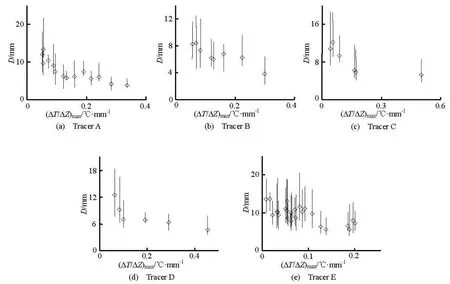
Fig.7 Relation between water body max temperature gradient and finger widthD(◊ is the finger width median in each measurement, Error bars show the standard deviation of each measurement)
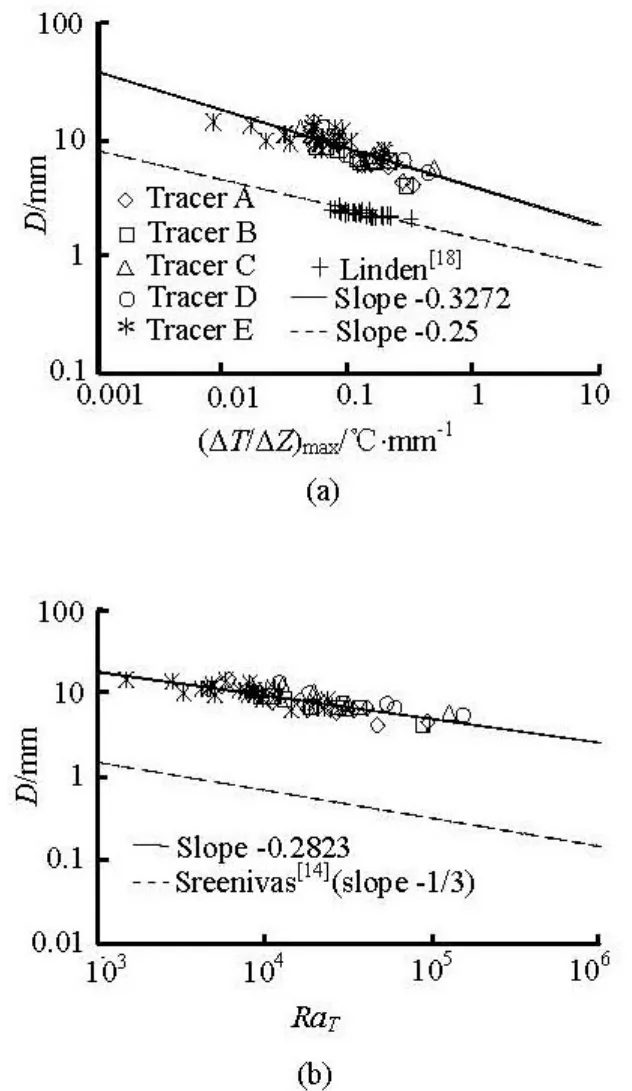
Fig.8 Relations of the water body max temperature gradient and the thermal Rayleigh numberRaTagainst the average finger widthD(the vertical characteristic length ofRaTisΔz=10mm )

The gradient ratioRρis used to indicate the strength of the double diffusion[6]. Figure 9 shows the finger width distributions against the gradient ratio, which reveal inverse correlations between the finger width and the gradient ratio,Rρ. For different stratification intensities, the relations between the finger width and the gradient ratio are totally different, most likely due to the fingering of the first category. Compared with the tracer density and the quantity of the tracer release, the finger width is affected more significantly by the stratification intensity to some extent. But heavier tracer or larger quantity of release could make the tracer cloud passing through the thermocline layer easily, then the salt-fingering would not be observed.

Fig.9 Relation between the density stability ratio Rρand the average finger width D (PLIF experiment for tracer E)
The tracer blobs, away from the main cloud, make the hypolimnion layer tracer content higher than the expected value. According to the PLIF experimental results, the blob contents which sink into the hypolimnion layer are accounted for about 5%-20% of the main cloud, in a fully developed salt-fingering (half minute after being released). The relation between the maximum water body temperature gradient and the hypolimnion layer tracer content is shown in Fig.10, where it is also shown that the blob content value in the hypolimnion layer decreases with the increase of the stratification intensity, proportional to –0.4353 power of ΔT/Δz. With the increase of the stratification intensity, the number of fingers of the first category finger decreases, and that of the second category increases. The fingers of the first category finger are much larger than those of the second category, so with the increase of the stratification intensity, the blob content value in the hypolimnion layer would be decreased.
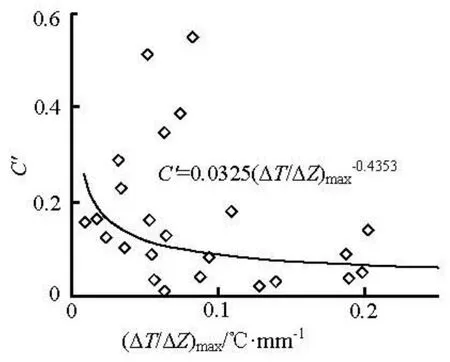
Fig.10 Relation between water body max temperature gradient (ΔT/Δz)maxand hypolimnion layer tracer content c′
4. Conclusions
From the experimental studies of vertical mixing in the static state thermal-stratified water, the following major conclusions are drawn:
(1) Vertical mixing would be retarded in the thermal-stratified water.
(2) In the stratified water body, the density tracer is retarded at the thermocline layer, the salt-fingering would occur. There are two ways to form the salt-fingers, by turbulent vortex and by double diffusion.

(4) The tracer would be distributed vertically deeper than the diapycnal mixing, which is caused by the salt-fingering. According to measurements, the blob contents are accounted for about 5%-20% of the main cloud, and are decreased with the increase of the stratification intensity. The salt-fingering plays a very critical role in the decision making.
Acknowledgement
Prof. Luo Lin is the supervisor of the first author, who is grateful for his many valuable instructions and suggestions. Prof. Luo Lin suffered a sudden cerebral hemorrhage, and passed away in October 11th, 2009. This article is dedicated for his memory.
[1] DENG Yun, ZHAO Wen-qian and LI Jia et al. Simulation on thermal stratification of the huge-cubage and deep reservoirs[C].Proceedings of the 29th IAHR Congress.Beijing, China, 2000, 9: 584-593.
[2] GARGETT A. E. Vertical eddy diffusivity in the ocean interior[J].Mar Res.,1984, 42(2): 359-393.
[3] STAQUET C. Mixing in a stably stratified shear layer: Two- and three-dimensional numerical experiments[J].Fluid Dynamics Research,2000, 27(6): 367-404.
[4] FAN Jing-yu, ZHANG Yan and WANG Dao-zeng. Experimental study on the vortex formation and entrainment characteristics for a round transverse jet in shallow water[J].Journal of Hydrodynamics,2009, 21(3): 386-393.
[5] QIU Xiang, ZHANG Dao-xiang and LU Zhi-ming et al. Turbulent mixing and evolution in a stably stratified flow with a temperature step[J].Journal of Hydrodynamics,2009, 21(1): 84-92.
[6] TURNER J. S.Buoyancy effects in fluids[M]. Cambridge, UK: Cambridge University Press, 1973, 367.
[7] STERN M. E. The “salt-fountain” and thermohaline convection[J].Tellus,1960, 12(2): 172-175.
[8] TURNER J. S. Salt fingers across a density interface[J].Deep-Sea Res.,1967, 14(5): 599.
[9] GREEN T., DIEZ T. Vertical plankton transport due to self-induced convection[J].Journal of PlanktonResearch,1995, 17(9): 1723-1730.
[10] CHEN C. F. Particle flux through sediment fingers[J].Deep-Sea Res.,1997, 44(9-10): 1645-1654.
[11] GREEN T., SCHETTLE J. W. Vortex rings associated with strong double-diffusive fingering[J].Physics of Fluids,1986, 29(1): 2109-2112.
[12] JIE Shi, HAO Wei. Evidence of double diffusion in the East China Sea[J].Journal of Marine Systems,2007, 67(3-4): 272-281.
[13] KRISHNAMURTI R. Double-diffusive transport in laboratory thermohaline staircases[J].J. Fluid Mech.,2003, 483(10): 287-314.
[14] SREENIVAS K. R., SINGH O. P. and SRINIVASAN J. On the relationship between finger width, velocity, and fluxes in thermohaline convection[J].Physics of Fluids,2009, 21(2): 026601-026615.
[15] TAYLOR J. Laboratory experiments on the formation of salt fingers after the decay of turbulence[J].Journal of Geophysical Research,1991, 96(C7): 12497-12510.
[16] PETERS W. D., VENART J. E. S. Visualization of rough-surface gravity current flows using laser-induced fluorescence[C].International symposium on flow visualization 9th.Edinburgh, Scotland, UK, 2000, 244-254.
[17] MA Fu-xi, LI Zhi-wei. Large eddy simulation of pollutant movement in water[J].Journal of Hydraulic Engineering,2002, (9): 55-60(in Chinese).
[18] LINDEN P. F. On the structure of salt fingers[J].Deep-sea Res.,1973, 20(4): 325-340.
[19] LI Xi, CHU Vincent. Rayleigh-Taylor instabilities by overturning experiments in tank[J].Journal of Hydrodynamics, Ser. B,2007, 19(3): 303-308.
January 14, 2010, Revised April 8, 2010)
* Project supported by the National Natural Science Foundation of China (Grant No. 50679049).
Biography:(1978-), Male, Ph. D. Candidate
LI Jia, E-mail: lijia@scu.edu.cn
2010,22(3):430-437
10.1016/S1001-6058(09)60074-3
- 水动力学研究与进展 B辑的其它文章
- A MULTI-SCALE APPROACH FOR THE ANALYSIS OF PROPER SAMPLED DATA SCALE IN HOT-WIRE EXPERIMENT OF SQUARE DUCT FLOW*
- SENSITIVITY STUDY OF THE EFFECTS OF WAVE-INDUCED VERTICAL MIXING ON VERTICAL EXCHANGE PROCESSES*
- ANALYTICAL STUDY OF WAVE MAKING IN A FLUME WITH A PARTIALLY REFLECTING END-WALL*
- BROADBAND ROTOR NOISE PREDICTION BASED ON A NEW FREQUENCY-DOMAIN FOUMULATION*
- NUMERICAL SIMULATIONS OF WAVE-INDUCED SHIP MOTIONS IN TIME DOMAIN BY A RANKINE PANEL METHOD*
- FLOWS THROUGH ENERGY DISSIPATERS WITH SUDDEN REDUCTION AND SUDDEN ENLARGEMENT FORMS*

